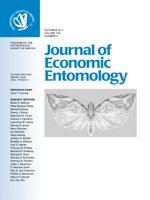Psyttalia concolor (Szèpligeti) (Hymenoptera: Braconidae) is a koinobiont endoparasitoid of several species of tephritid (Diptera) larvae, such as Bactrocera oleae (Gmelin) and Ceratitis capitata (Wiedemann). Here, we report on the effects of imidacloprid and fipronil on P. concolor females, when different routes of exposure were evaluated: residual contact (cover and bait sprays) and via treatment of host species. Moreover, the persistence of the bait formulated compound also was studied. For each experiment, lethal (mortality) and sublethal effects (parasitization rate or longevity) were studied. Fipronil produced 100% mortality irrespective of exposure route, and it was very persistent, because 34-d-old residues still produced this high mortality rate, being as toxic or even more toxic than the reference product dimethoate. Toxicity of imidacloprid depends on the mode of exposure, although always remained less toxic than dimethoate. Imidacloprid caused high mortality or sublethal effect to the progeny in cover sprays and when applied via treated host, being harmless in bait sprays application. In conclusion, our results suggest that fipronil should not be used in the field when the parasitoid is present. On the contrary, although imidacloprid is physiologically active against females of P. concolor, ecological selectivity may result through the use of bait treatment.
BioOne.org will be down briefly for maintenance on 17 December 2024 between 18:00-22:00 Pacific Time US. We apologize for any inconvenience.
How to translate text using browser tools
1 October 2011
Lethal and Sublethal Toxicity of Fipronil and Imidacloprid on Psyttalia concolor (Hymenoptera: Braconidae)
Ángeles Adán,
Elisa Viñuela,
Paloma Bengochea,
Flor Budia,
Pedro Del Estal,
Pedro Aguado,
Pilar Medina
ACCESS THE FULL ARTICLE
It is not available for individual sale.
This article is only available to subscribers.
It is not available for individual sale.
It is not available for individual sale.

Journal of Economic Entomology
Vol. 104 • No. 5
October 2011
Vol. 104 • No. 5
October 2011
fipronil
imidacloprid
Psyttalia concolor
side effects




